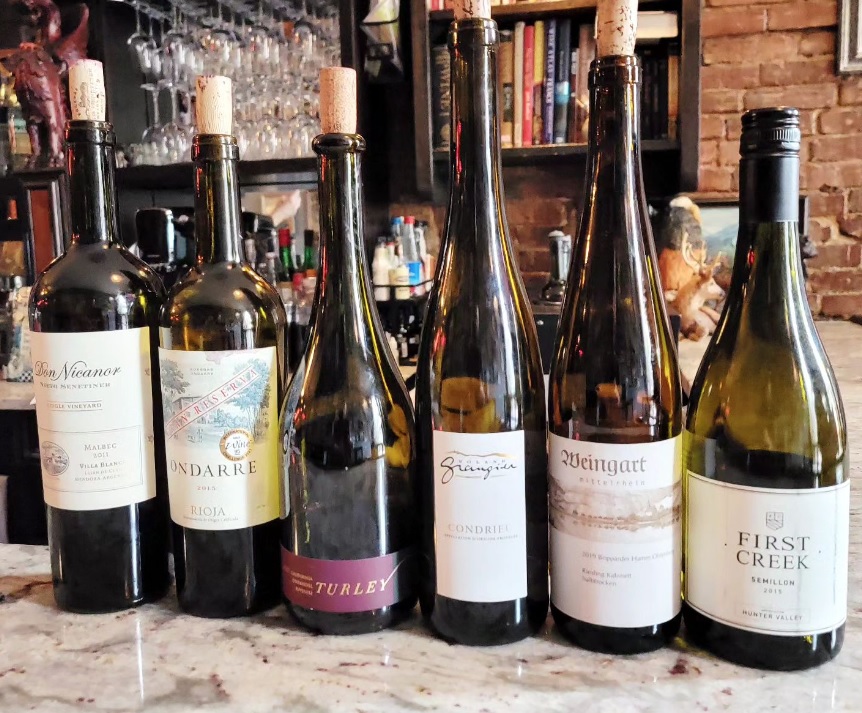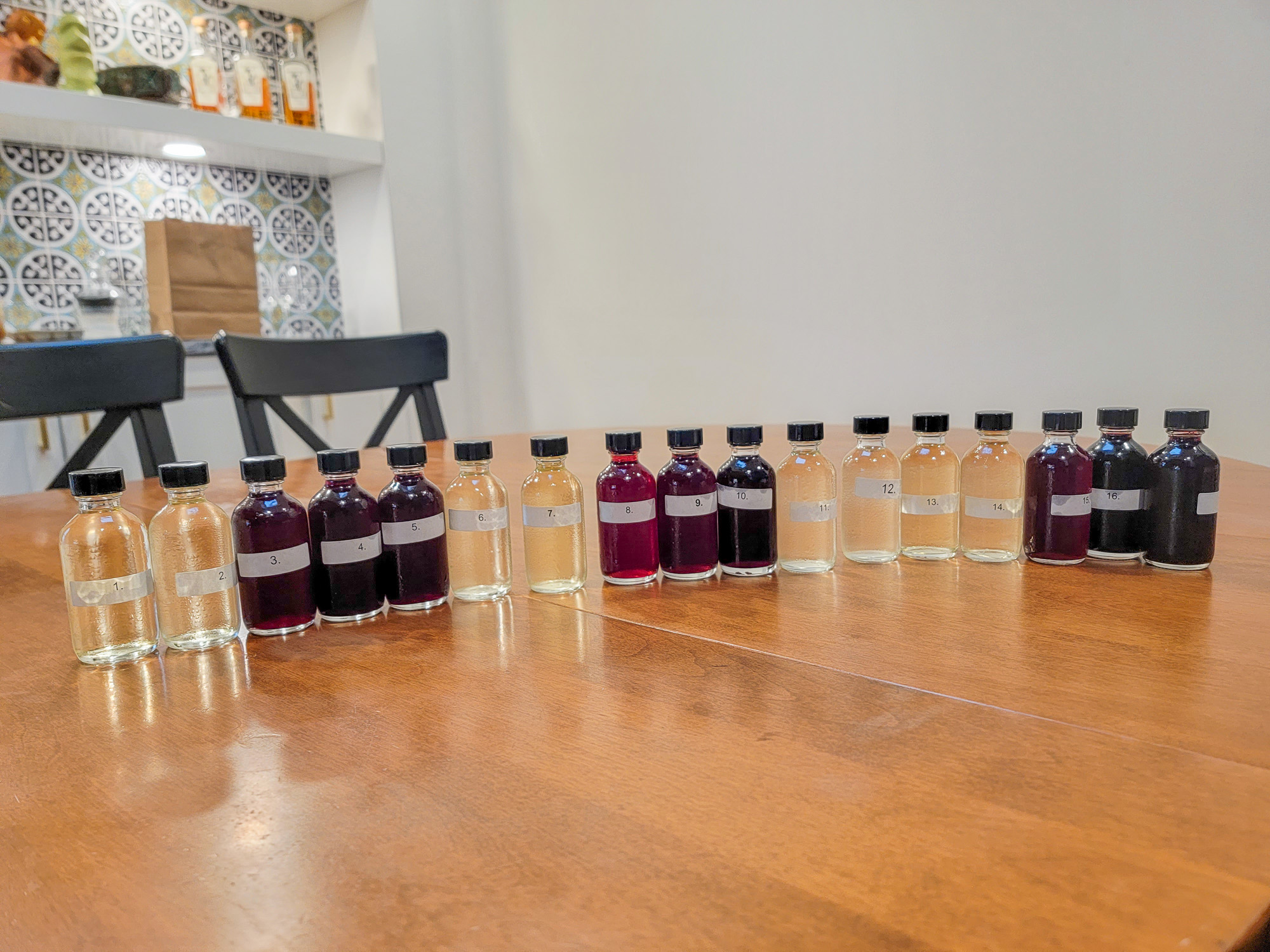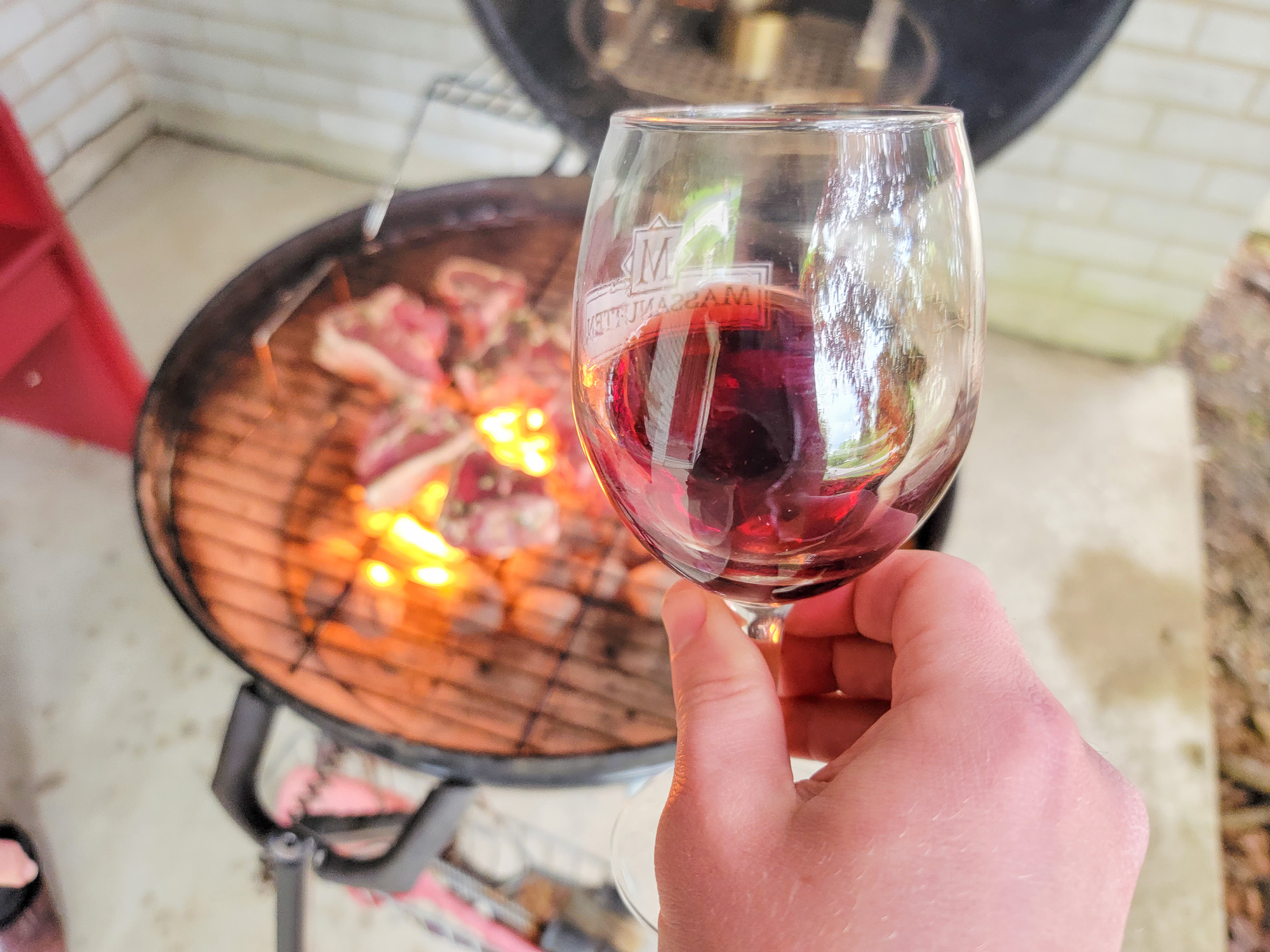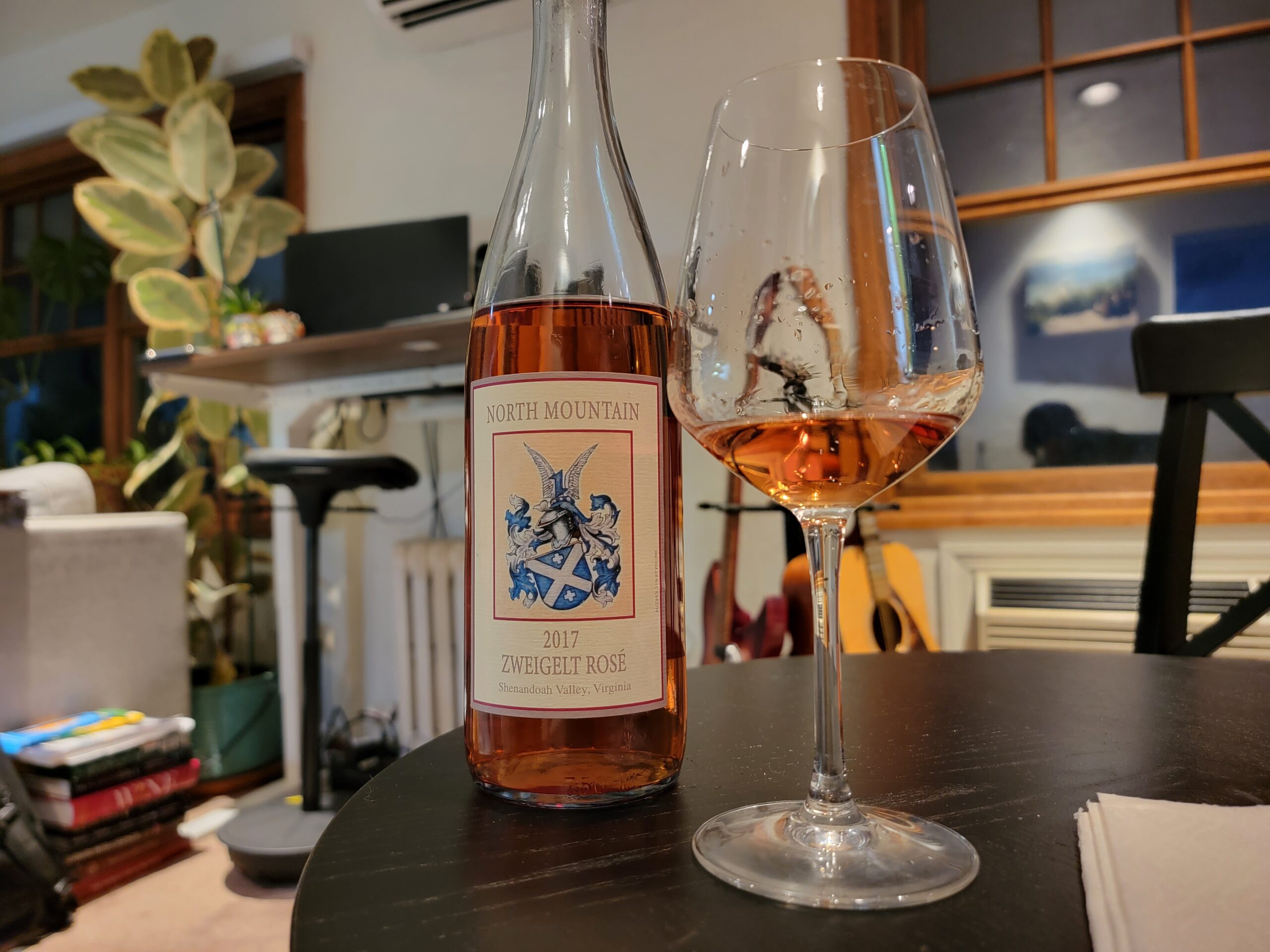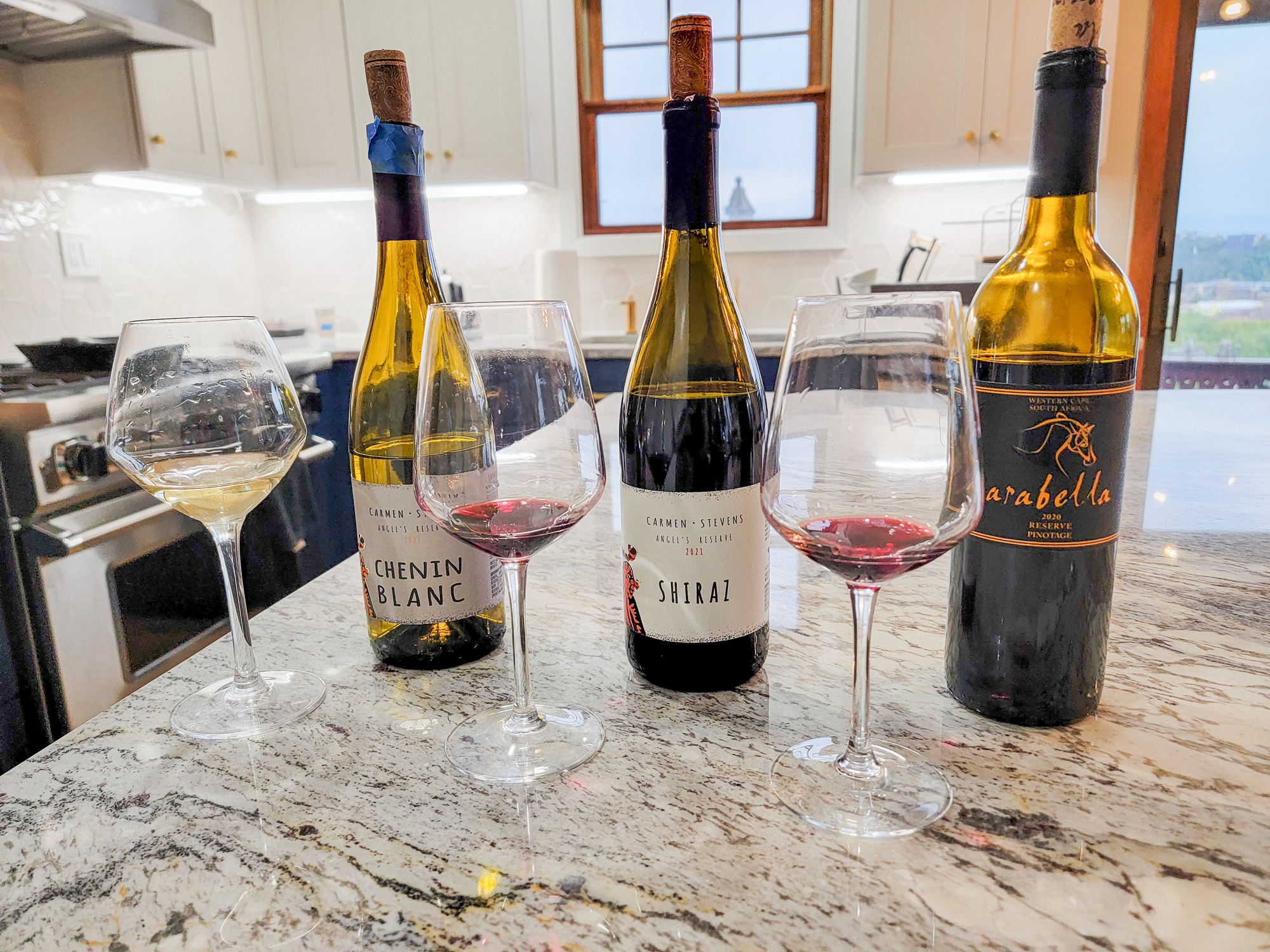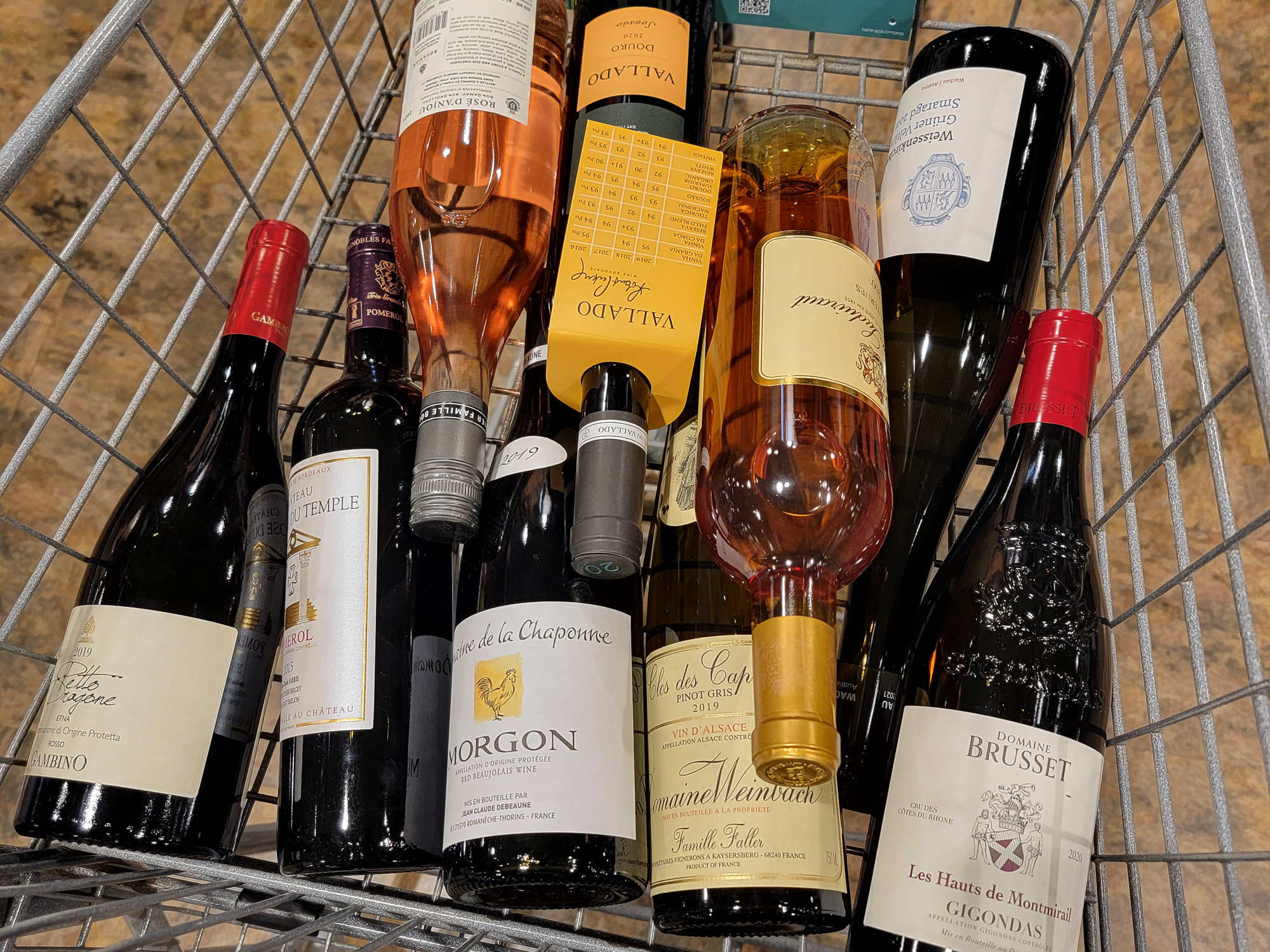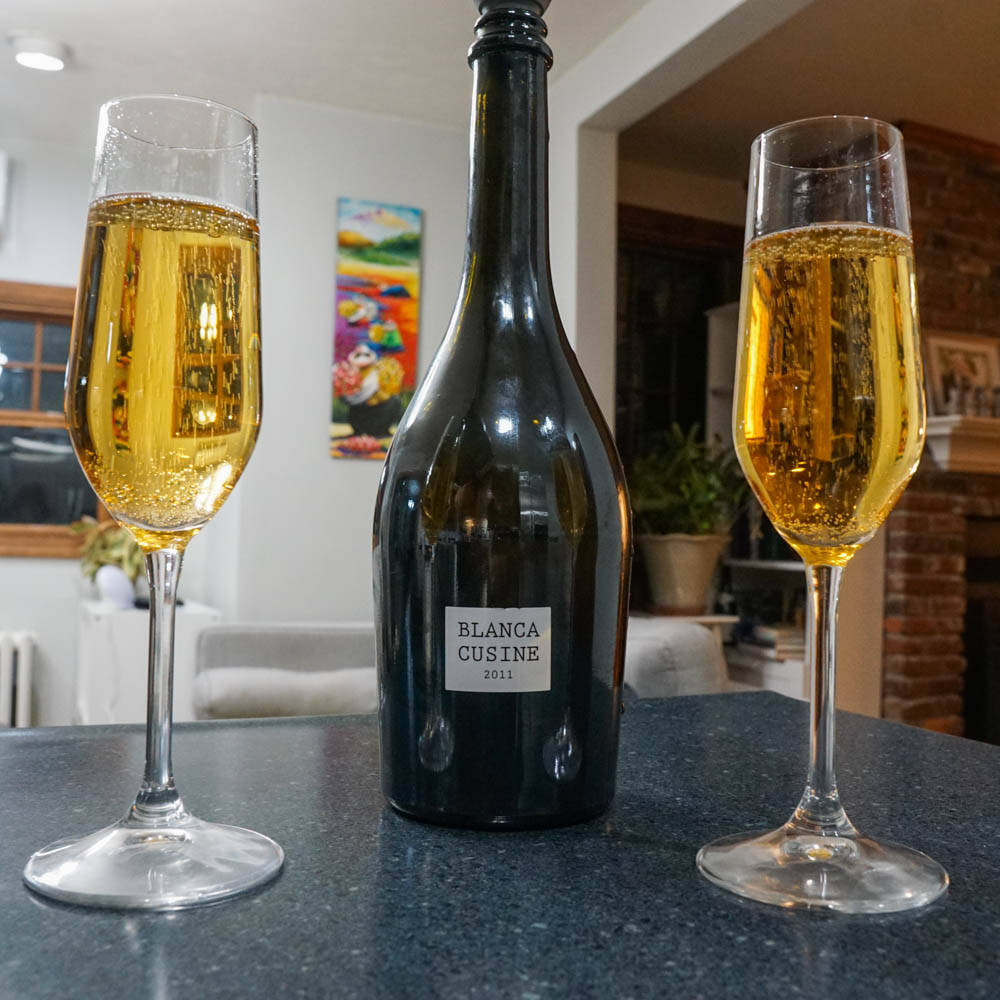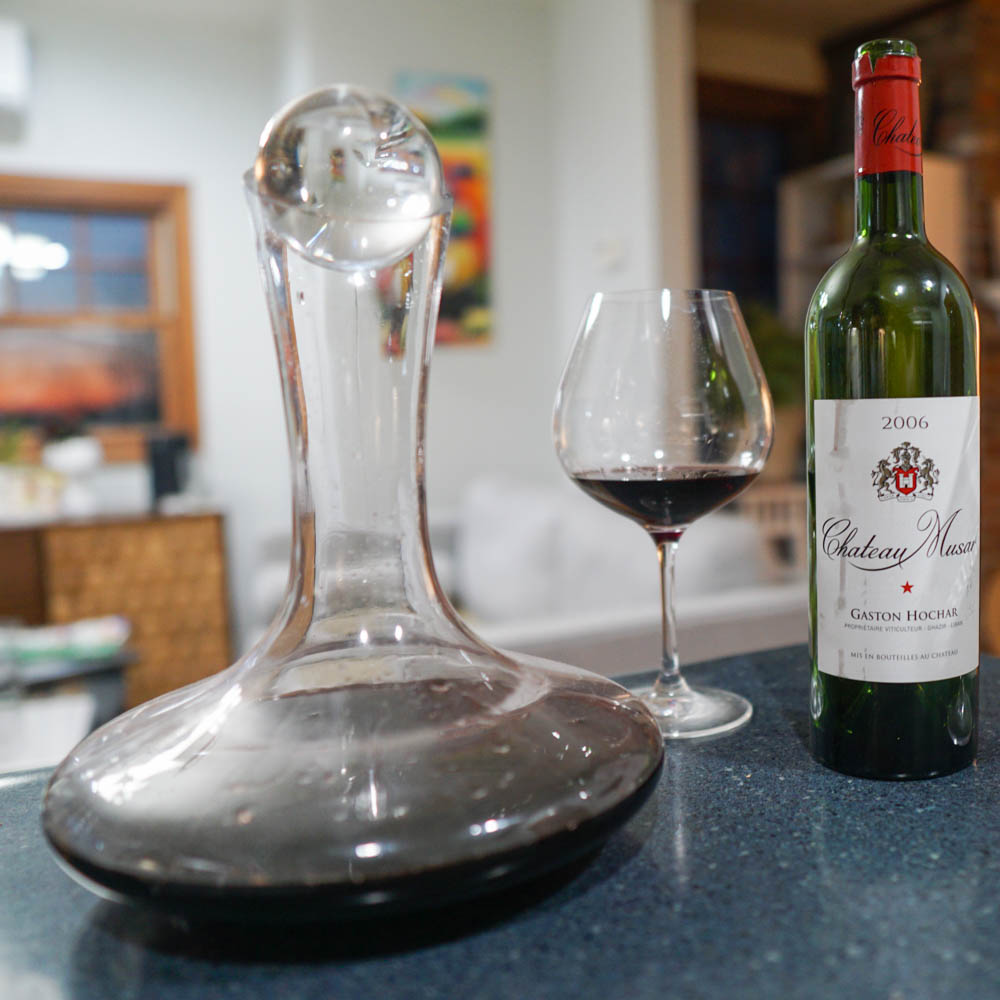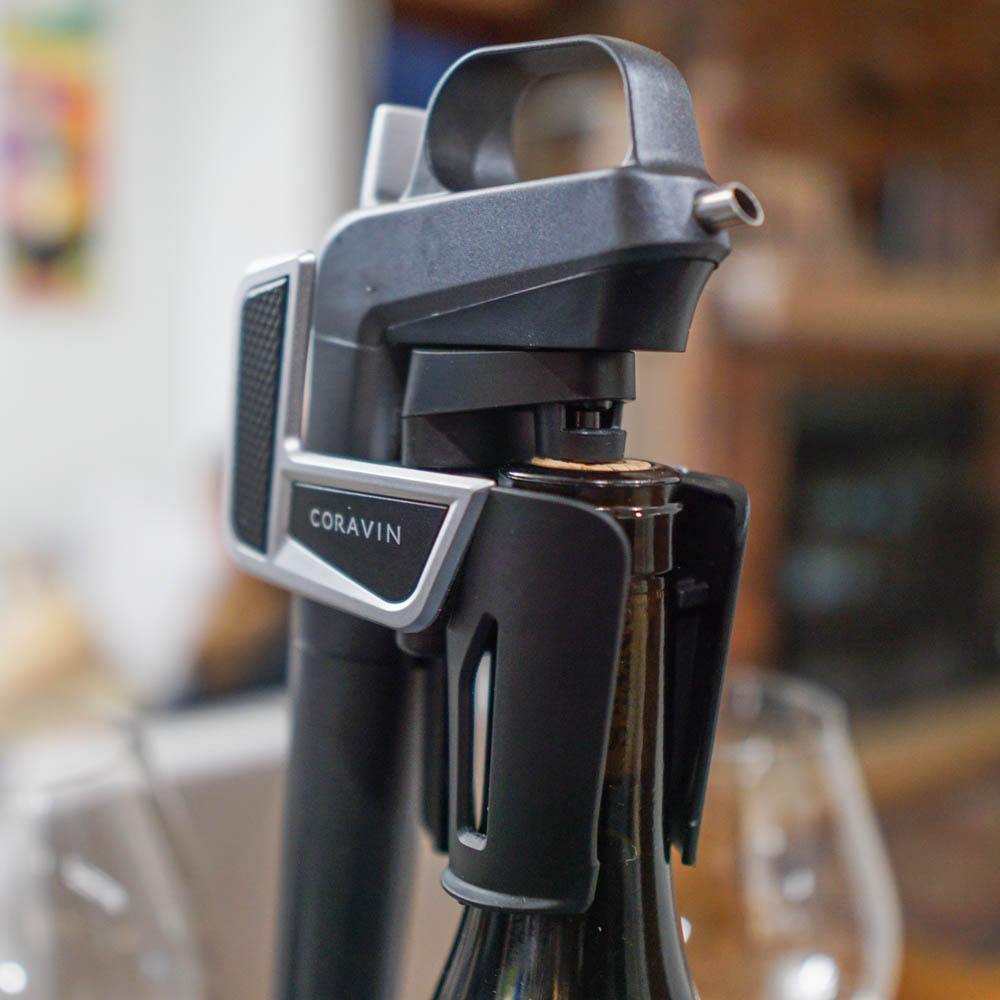Published by Jeremy.
Disclaimers: We use demographic data, email opt-ins, display advertising, and affiliate links to operate this site. Please review our Terms and Conditions for more information. This website is intended for those of legal drinking age in your jurisdiction.
One of the things students in WSET Diploma classes must learn is how to taste wine blind. Part of this is simply to get better at tasting wine. The other part of this is that the WSET Diploma exams that have tasting components often require us to identify characteristics in the wine such as its quality, grape(s), country of origin, and production style to name a few.
We'll start this one with some bad news- blind-tasting wine isn't easy. There is no one-size-fits-all approach to blind taste wine and ultimately coming up with the required answers (for a structured course or just for fun).
The good news, however, is that there are several processes you can follow to help you get close if you have to make an educated guess. This involves a robust analysis of the wine in the glass before you and referencing the clues you find to the wine theory you have learned along the way.
Ultimately, for those taking advanced wine classes, like WSET Diploma, being 100% right on guessing the grape, country, or production style is simply bonus points to help increase your score to a merit or distinction level rating. In programs like WSET, you can still pass a tasting exam by having good tasting notes and being wrong on your final guesses- the program cares about you learning to identify the quality of wines above all others, after all.
So let's dive into everything we think about when tasting blind!
Note: I took the WSET Diploma D3 exam in May 2023. Test material and structure can and does change over time. I passed all modules and passed D4 and D5 with merit.
WSET Diploma Tasting Exam Details
For students in the WSET Diploma program, we should take a quick look at the three structures of wine-tasting exams you will encounter (other program formats may differ):
- D3 – Wines of the World – Twelve still wines to be evaluated during two (2) 90-minute exam periods arranged back-to-back. Each exam period will have six wines poured at once in two themes (three wines each). The D3 theory exam is administered on a separate day without any wine tasting. Students will be graded separately on theory and tasting in D3- if you fail one and pass another, you only resit the part you failed.
- The wines are segmented into four themes of three wines each: 3x Same Grape, 3x Same Country, 3x Same Region, and 3x Mixed Bag. This will be discussed in greater detail later. Generally speaking, the flight style should be noted in the exam (e.g. same grape).
- D4 – Sparkling Wine – Three sparkling wines to be evaluated during a 90-minute exam that combines both theory and tasting portions. This exam is graded cumulatively, and those who fail must resit both portions.
- D5 – Fortified Wine – Three fortified wines to be evaluated during a 90-minute exam that combines both theory and tasting portions. This exam is graded cumulatively, and those who fail must resit both portions.
During each exam, students are expected to evaluate each wine based on the WSET systematic approach to tasting and may be asked to answer follow-up questions for any given wine that could include notes on identifying the grape, country of origin, region of origin, method of production, category and style of wine (e.g. Vintage Port for style/category respectively), the potential for aging, or more specific questions unique to the wine(s) like category or style.
This article breaks down my approach to blind-tasting still wines in the WSET Diploma tasting grid, discussing what I'm looking for and thinking about at each particular point (e.g. what tannins tell me about the wine, its origin, winemaking choices, etc).
This article is formatted for still wines (D3) and does not discuss the unique elements of sparkling and fortified wines. Caveats associated with these exams are shared in more detail in our WSET D4 exam tips and WSET D5 exam tips posts, respectively. That being said, a fair bit of the logic discussed below can apply to sparkling and fortified wines.
So let's break down each of the elements of the WSET tasting grid to see what they're all about!
Appearance
How much information can you truly extract from the color of a wine? The answer is both very little and a lot at the same time. This will make sense in a moment, I promise.
WSET tasting guidance gives three main categories we look for when it comes to the appearance of wine: intensity, color, and other observations. We should discuss these and break them down into all the information you could extract.
Let's first start with color. Color gives a lot of clues when it comes to the glass in front of you. First, the easy one is telling the difference between red and white wines as they likely come from red and white grapes (wineries have made white wines out of red grapes with a very delicate extraction process, but most programs ignore these).
Okay, fine, you already knew that.
But within a grape, color may indicate a lot. First up is age. White wines that appear amber and red wines that appear garnet or tawny (all hues of copper/brown to a degree) indicate that a wine has likely seen some age- most likely in the bottle. This is a cue to look for tertiary notes in subsequent categories outright as these colors likely do not appear without a sufficient period of aging.
Can you have aged characteristics in wine without this cue? Absolutely, but the color is still an indicator all the same.
For young wines, things get a bit less clear. Can the difference between a lemon and gold wine give you a clue about the white grape? Possibly, but it could also be a function of skin extraction or age. Can the difference between purple and ruby wine give you a clue about the red grape? Maybe, some grapes do trend one color or another as discussed in theory (Zinfandel, Malbec, and others do trend closer to purple), but again extraction, age, or even blends may make this one not reliable on its own.
Rose wines can be made through a mix of methods; however, generally lighter color wines are made via the direct press method whereas deeper, richer colored rose tend to be made with the saignee method. These may not be noted in the color section; however, if you get a winemaking question at the end you may want to tuck that knowledge away for later.
All of these, after all, simply cues to look for to tie into theory, but none alone will tell you what the grape is. At this point, you're simply noting what you see and reserving this knowledge for later reference.
Up next, is intensity. How far does the color go to the edge of the rim (white) or how deep is the color when looking top down (red)? The best analog for these falls around skin thickness, pigmentation, and extraction techniques.
If a white wine's color fades quickly, with a lot of clear rim seen, I call pale. If the color goes all the way to the rim without diminishing much, deep. Anywhere else, medium. If you can read text while looking through a red wine perfectly fine, pale. If you can see the base of the stem looking down but not read text, medium. If you can barely see the base of the stem or not see it at all, deep. These are, of course, rough approximations which may need to be tweaked for each wine.
To me, the details you can get from this one tend to only be best in the extremes and, of course, for pure varietal wines only (as many winemakers blend to adjust the color intensity, for example).
A good example is the difference between Pinot Noir and Cabernet Sauvignon. Pinot Noir is a thin-skinned grape, whereas Cabernet Sauvignon is typically thick-skinned. Naturally, pending extraction techniques, one would expect most varietal Pinot Noirs to be on the paler side and most Cabernet Sauvignons to be on the deeper side. So if you get a wine that could be a Pinot Noir from other characteristics, but is deep in color, you may need to stop and think about this one more as this doesn't make much sense in most cases.
By memorizing some grape characteristics in theory, a few logical deductions may be made to a small degree. Again, appearance can't be used to identify a wine alone, so file away these thoughts for later.
Finally, there are other observations. This category is broad and is simply anything else you may notice in the wine. Are there light bubbles? This could be a winemaker's choice of injecting some CO2 (a la Vinho Verde) or cooler fermentation. Is there sediment? This could be a sign of age. Some even ascribe to the thought that the legs of the wine correlate to viscosity to residual sugar and/or possible alcohol content (this isn't covered in WSET evaluations, but people still use it).
Will any of these characteristics tell you what the wine is? No. But these are pieces of the puzzle. In a way, this step is about eliminating possibilities as much as it is being used to determine what the wine is outright. You may be able to start doing this from visual observations alone.
- I mentioned above that the extreme ends of intensity are perhaps the most helpful in wine, but in practice, many wines fall into a medium category. In this case, I'd be hesitant on extracting too much information if only because there are so many variables at play that could change the wine. Is it a blend? Is the wine older and the color is fading (red) or intensifying (white)? What about the other 231 winemaking choices that could impact the appearance? Okay, that last number is random, but you get the point here- there are too many variables in mid-tier scenarios for my liking. As such, you can learn a lot (what it is not) and very little (what it is)- possibly at the same time.
Aromas
Next up, smell the wine. Here, we are looking at two particular things- intensity and aroma characteristics.
Let's start with intensity. How aromatic a glass of wine is may give you an indication of the grape, as some are much more aromatic than others per theory. Generally speaking, the further away your nose is from the glass, the more intense it is, and, while not necessarily a considerable cue one way or another, is still a data point to keep in mind.
So if you can smell the wine from a foot or more away, it is probably pronounced aromas. If you have to put your nose all the way into the glass and can barely smell anything, it is most assuredly light. Note it, and move on.
- It is worth clarifying here that intensity is not the same as complexity. The intensity of wine is a measure of how strong the aromas are. This could simply be one aroma (like lemon) that is incredibly potent. If you are picking out 37 unique aromas, that does not make a wine intense, it makes it complex, which for structured wine-tasting programs list WSET are two different things- this will be discussed more in the final evaluation.
Up next, the characteristics proper. Here is where theory can come into play. What aromas are you smelling and what aromas are you not smelling? Aromas here may give you an indication of the grape but also may give an indication of the climate, soil, winemaking choices, and age characteristics to name a few.
Chardonnay is a fine example to illustrate here. When this grape is only just ripe, it may have aromas of citrus fruit like lemon and lime. When the grape is very ripe, the aromas may move into stone fruit territory and even onward to tropical fruit. Would I expect a Burgundian Chardonnay to smell of pineapple? That seems unlikely- not impossible (Macon is warmer than Chablis, after all), but unlikely. Would I expect one from California Chardonnay to reach that level of ripeness? Absolutely.
If there is a strong amount of vanilla or toast, I would then move on to assuming that the winemaker had aged this one rather aggressively in a barrel. This is possible for France but is also rather unlikely- Old World wines generally tend to be light on oak usage in most cases (Spain often being an exception due to many producers using American oak). Overly oaked wines would move me into a New World scenario simply because Burgundy Chardonnays often showcase primary fruit and restrained oak above all others.
- American oak can be even more intense than French oak and oak from other origins- so if you are getting an incredibly intense sweetness, coconut, and other oak characters, you may be looking at some California wines, Chile, Spain, or Australia as possible origins.
Butter and cream may be a sign of malolactic fermentation, too, and perhaps faint toast or biscuit could be a sign of lees aging as well- good signs for quality and winemaking choices, but perhaps less so on guessing the grape or region of origin. Many white wines have lees aging; however, malo may indicate that the grape was overly acidic (possibly from a cool climate) and needed to be restrained slightly.
Ignoring winemaking choices, the trap here is that aromas are not solely tied to region and local climates. Some grapes may only smell of one type of fruit no matter how ripe it is (e.g. citrus), but other grapes may have unique characteristics that only a very limited number of grapes express (e.g. if you are smelling petrol, I'd bet with a high degree of certainty you're smelling an aged Riesling; if incredibly grass-forward, a Sauvignon Blanc- possibly from New Zealand).
Where I struggle in blind tastings is that my nose has a tough time picking up on nuanced aromas. Restrained peach, petrol, and grass are all somewhat similar to me unless at the extreme end. Other notes, particularly herbal characteristics, are also somewhat lost on me. I cook with herbs a ton, but in wine I really can't get them at all. As such, the furthest I can say an aroma takes me to is a possibility of climate and winemaking choices- but those who are better skilled may be able to isolate aromas that only certain grapes have per theory and can well on their way to a guess at this point.
- You may have an idea of what the grape could be at this point, but be careful about committing to any given idea early. If you go down the wrong path at this step, you may find yourself writing theory answers that support your guess and not necessarily reflect what you're actually experiencing in a wine. Note the important cues- hints on climate, winemaking choices, possible unique aromas, etc., dissociate from what guesses you may have at this point, and move on.
- On the D3 exam, you need to have a minimum of five aromas to get full points. Try and get at least 10 if possible. If a wine has secondary (winemaking) and tertiary (age) notes, be sure to include them as evaluators typically require at least one (1) of the five to be secondary and/or tertiary aromas if present. If both are present in the wine and you only note primary (fruit) characters, you may only top out at three points.
Structure and Flavors
When it comes to analyzing the structure of a wine, WSET tasting asks you to cover sweetness, acidity, tannin (if red), alcohol, balance, flavor intensity, flavor characteristics, and finish- or SATABFFF as I like to write it out in shorthand for memorization purposes.
Sweetness is a measurement of residual sugars within the wine, and in D3 in particular the vast majority of wines will most likely be dry. This is, of course, not helpful when guessing the wine. But if you have wines with residual sugar beyond the dry category, your options are substantially reduced.
Did the winemaker stop fermentation to have residual sugar, thus lowering the alcohol considerably? This may drive you to a winemaker choice for select grapes- German Riesling, particularly from the Mosel, comes to mind here. Is the alcohol medium or high, suggesting that fermentation may have stopped naturally? This may push you to look for dried grapes, late harvest, or botrytis characteristics and may reduce your options relative to just how sweet the wine is.
If I detect a minor amount of sugar, I will likely call off-dry. If the wine has residual sugar but it is more dry than sweet, medium dry. If it is more sweet than dry, medium sweet. If it is much higher in sugar, like a botrytis or late harvest, sweet. If it is so sickenly sweet that it is almost like syrup, luscious. The only wine I've ever had that was luscious was a Trockenbeerenauslese, and once you have had one of those you'll know what I mean.
Acidity is, to me at least, a measure of how much I salivate when a wine hits my tongue. I typically analyze this based on the first perception as the wine touches my tongue, but your rules may vary. If the wine feels flabby, low acidity. If I salivate intensely for several seconds, high.
Much like other metrics, the extremes are very telling for some grapes. Viognier and Gewurztraminer are naturally lower in acidity whereas Riesling is naturally higher. The middle range is where things get tricky- is the acidity medium because of the grape's natural characteristics or does the grape lose acidity as it gets riper? Medium acidity could be a cue or a trap depending on how you look at things.
- The nature of acidity could tell you a lot, too. Beyond Flavour is a great resource that diagnoses the structure of acidity in white wines, which some students find valuable. Chardonnay is described as a linear acidity whereas Chenin Blanc is crescendo, and after tasting a ton of them I can safely say that yes, yes they are. But as this is a 3rd party resource, tread lightly when using it in any structured program. I am not touching on this in the article because the ideas are outside of WSET material.
Tannin is something measured only for red (and orange) wines as tannins are extracted from the skins. Much like acidity, tannins can tell you a lot, depending on the wine. Some grapes are naturally high in tannin (Nebbiolo) due to having thicker skins. Some grapes are naturally low in tannin (Pinot Noir) due to their thin skins. But the extraction of tannin is also a winemaking choice. Winemaker A may macerate Nebbiolo for a long period during fermentation, thus extracting more tannin, whereas Winemaker B may only cold soak pre-fermentation, thus lowering tannin extraction.
Again, the extremes can be telling here more than anything else. When you get into the medium characteristic range it could be a function of the grape or it could be a function of winemaking choices. Having a broad understanding of this theory element can go a long way here.
- Beyond Flavour discusses the tannin structure for red wines as well; however, I found this one a bit more challenging than acidity. But, again, keep in mind that 3rd party resources are not endorsed by most programs so you run a risk in relying on it.
In WSET Diploma, you also have to describe the nature of the tannins as well. One keyword is enough, but two may be a good hedge. Coarse, chalky, and vegetal are often considered to have negative connotations and fine-grained, smooth, ripe positive. First, determine if the tannins are pleasing or oppressive, then try and articulate why. I would not worry about this point too much, but it is still something to address to get points. But if you can settle on a reason why (e.g. stalky, vegetal, etc.) you may be able to extract a possible reason that could push you to a grape and/or winemaking choice (fermenting whole bunch may extract woody tannins from stems, for example).
Alcohol can be a function of the grape, climate, or perhaps even vintage as this is how much sugar has been accumulated in the grape and subsequently converted to alcohol. This is often measured as a burning sensation on the tongue in the form of “heat”. If it is low, there will be none (and the wine may even be lighter in body as a result). If it is medium, you may start to notice a bit. If it is high, you will have a lingering heat that cannot be ignored.
As most wines are naturally within the medium range by WSET standards, I go into this assumption and need to be convinced otherwise. When in doubt, I call medium as a hedge.
It may be annoying to say yet again, but the extremes are where you can gather the most details. If you have a dry wine with low alcohol, the odds are very good it is from a cooler climate. The grapes simply ripened without accumulating too much sugar- often something seen in cool climate areas (e.g. Burgundy, Mosel, etc.). If the wine is dry and extremely high in alcohol (e.g. 15.5%), you're almost certainly looking at warm to hot climates (e.g. Spain, southern Italy, Greece, California, etc.). One extremely high ABV wine next to a cooler climate wine (let's go with an obvious Riesling) likely takes Germany out of the picture in a country flight- so be aware if alcohol feels out of place for your guesses.
Body is a measure of the weight of the wine on your palate. This is often considered a function of alcohol, residual sugar, glycerols, and others, but is not necessarily a perfect connection for any one item. A high-alcohol wine can have a medium body. A medium-dry wine can be light. It is not perfect, but it is a starting point for making connections.
Can you tell much about a wine from the body alone? Perhaps, some grapes per theory are naturally full body or naturally light, but it also may be a stretch here in a vacuum without comparing other notes.
Flavor intensity and characteristics are a lot like the aromas, just on your tongue.
If you are struggling to pick up any flavors at all, the wine is light intensity. If you are getting a ton of flavors the wine feels like it is exploding, pronounced. Somewhere in between, medium. Closer to that lighter side? Medium(-). Closer to that pronounced side? Medium(+).
Much like with aromas, intensity and complexity are two different things. A wine can be incredibly intense with just one or two notes. A wine can be medium(-) or light and have 10 faint flavors.
Here you generally need four flavor notes, including at least one secondary and/or tertiary note if those are present. Shoot for 10 to give yourself a hedge. You can also score a point for other observations here and you can note things like “oily”, “waxy”, “phenolic”, or other characteristics that may also give you later cues to the grape or origin of the wine.
Finish is how long the flavors remain on your tongue after you swallow (or spit). The emphasis here should be on flavor, and WSET often describes it as “pleasurable” characteristics of flavor, as things like alcohol, acidity, bitterness, and other non-flavor components may linger far longer than flavors.
Out of all the classes I've taken, there is no real uniform answer for what constitutes a “short” vs “long” finish. You ask a different instructor and you get a different answer every time. To me, I simply count from the moment I swallow and see how long the pleasurable flavors remain. If they disappear within one second, short. Two, medium(-). Three, medium. Four, medium(+). Five or longer, long.
Is this a good gauge? Not really. But this is generally how I've equated calls from instructors with counting on my own.
You'll note that in the above I have very limited commentary on using any of these to guess the grape, country, or region of origin. Here you simply want to have good-tasting notes to reflect what is going on in the glass. Make notes of what observations you have and keep those in your back pocket for the later sections of the exam.
Quality Assessment
In WSET, you must finish your tasting notes with a quality assessment. This is perhaps the most crucial part of any wine-tasting exam as WSET pushes students to understand wine quality above all others.
For WSET exams (Level 3 and Diploma), you must conclude whether the wine is poor, acceptable, good, very good, or outstanding and then justify your answer in writing. The logic for these is often tied to the BICL scale of Balance, Intensity, Complexity, and Length as these are components evaluators want you to comment on in your justification. (Other elements, like integration, can be discussed, too, if you have thoughts on it.)
For my own tasting, I rate each of these components on a scale of 0, 0.5, and 1 with 0 being “none at all / something is wrong”, 0.5 being “good, but something could be better”, and 1.0 being “no issues here- this component is good without qualifying” for any given category. These are perhaps not the greatest of word choices, but you'll see where I'm going with this in a second once I outline each category:
- Balance: If multiple categories (acidity, alcohol, flavor intensity, etc) are off-putting and/or not working well with each other, I call it 0. If only one category is off such that it is noticeable (say, alcohol is too high and stands out such that it is interrupting enjoying the wine), I call it 0.5. If everything works together fine enough without further commentary, I call it 1.0- the wine is clearly balanced.
- Intensity: Are the flavors and aromas slapping you in the face or are you struggling to find them? 0 would correspond to light intensity, 0.5 would be medium(-) to medium, and 1.0 would be medium(+) to pronounced in many cases. I'm only utilizing these as an example here as a starting point as your personal interpretation may vary (particularly where medium(-) and medium(+) would fall- the low or high ends of either of these may push you in another direction).
- Is the aroma more complex on the nose than the palate? You may have a case to justify 0.5 here. Is the aroma more complex on the palate than the nose? Some may consider this desirable, so you may justify swinging up to 1.0 if everything else was equal. This is not a hard and fast rule- just a common topic discussed in tastings.
- Complexity: Are you getting one aroma and/or flavor in the wine or 20? If you are getting a good bit, is it all primary character (just fruit) or are there secondary characteristics (winemaking choices) and tertiary notes (age), too? If there is only a handful of primary fruit notes in a single category (e.g. citrus fruit), I would say 0- it is not complex. If there are 5-7 primary notes in one or two categories (fruit, mineral, floral), you may give it a 0.5. Finally, if a wine hits you with everything (primary, secondary, and tertiary character), with 10 or 15 varied notes across several flavor categories, there is no real reason to give it anything less than 1.0- it is clearly complex.
- Earlier on in this article, I mentioned the trap of equating intensity and complexity, and this is why. A wine can be complex and not intense. A wine can be intense but not complex. Equating the two interchangeably could influence your quality statement.
- Length: How long does the flavor linger on your palate? This is directly related to your finish statement in the notes above. If a wine is short, you have no reason not to give it a 0 here. If it is medium(-) to medium, I'd probably go 0.5. If it is medium(+) to long, the only obvious answer here is 1.0. Obviously where you fall on this scale is up to your own interpretation (again, at the medium(-) and medium(+) ranges), but this is a rough start.
Now you sum up the scores you gave. It is unlikely you'll ever hit 0 on any wine, so poor to me is mostly reserved for if there is a fault present that would prevent you form wanting to serve a wine outright. These are rare, but my exam did have one (it would have been very good if the fault was not present). If you can only count to 1, the wine is acceptable- things are still very wrong in the wine (this is also rare for WSET to give one of these). If you get to 2, the wine is good- some things are done well, some things could be better. If you get to 3, very good- perhaps one or two small items could be better. If you can count to 4, then all of the components above were great and the wine is clearly outstanding.
In a WSET Diploma exam, you do not have to write out a numerical score here, but you have to justify your choice in writing to get full points. So take all of your thoughts from above and articulate them in writing (succinctly- you're on a time limit still!).
An outstanding wine could be described as “This wine has a pleasant balance of acidity and flavor intensity. There are pronounced aromas and flavor notes of [X, Y, Z] indicating primary, secondary, and tertiary characteristics indicating strong complexity and intensity. The long finish is pleasant and holds all flavors well. These come together for an outstanding wine without noticeable fault.”
On the other hand, a good wine could be described as “This wine has a strong intensity of primary fruits (X and Y), but lacks the complexity of secondary and tertiary aromas. The wine has a balanced acidity with the flavor intensity that is pleasing, but the alcohol is out of balance on the high side and is unpleasant. The short finish leaves you wanting more length. A very good example of this wine would have secondary and tertiary flavors, possibly of [X for lees and Y for age] and would have been fermented to a slightly lower final alcohol level for better balance.”
- If a wine is not outstanding, it is always good practice to illustrate what a wine one tier higher would be. This helps you explain possible faults with more clarity while elaborating on what you would expect a higher-quality bottle to be instead. If a reviewer called a wine very good and you called it good, but with a strong justification that they agree with, you may still get some points!
Ultimately, your quality statement should reflect your notes above all others as you are telling the story of the wine here. If you call the wine outstanding but say it has a short finish in your tasting notes, that clearly doesn't add up as you shouldn't be giving the length component of BICL many (if any) points. If you describe the quality of the wine as “complex” but do not list secondary and tertiary notes in the aromas and/or flavors, you are likely missing something unless the wine has an impressive array of primary fruit categories.
As such, for those reviewing their quality statement, if time allows, review your written text with your tasting notes for each wine. If you are telling the story of the wine well for the exam's sake, everything should make sense. Whether you are right or wrong is one thing, but don't lose points by having faulty logic here all the same. Having a well-written, logically concluded quality statement may still get you some points even when wrong- within reason of course!
Suitability for Further Aging
Most WSET tasting exams have one follow-up question asking you to identify the suitability for bottle aging. Here, there are generally two options you may consider:
- This bottle is suitable for further aging
- This bottle is not suitable for further aging
For a bottle to be suitable for further aging, you need to have a justification for what the benefit would be to holding. Will the tannins mellow? Is the acidity high enough to hold for a pleasurable experience? Are there enough primary fruit notes that would develop into tertiary aromas/flavors with time?
Generally speaking, there should be clues in the wine to tell you that it can improve with age- likely a function of several of the above points combined. Strong secondary notes in tandem with higher acidity/tannin are a good clue. Some tertiary notes already being present with strong primary fruits remaining could be another- the wine is clearly already developing some and has enough primary fruit to develop further. Sparkling and fortified wines have other caveats to keep in mind, too (like lees intensity for traditional method sparking). All of these can be used as justification.
Wines unsuitable for aging tend to be a bit easier to justify. Acidity is lower, tannins are mild, and there are no notable secondary or tertiary aromas/flavors present to name a few. In many cases, the primary fruit intensity is not strong enough, too (high acid, medium flavor intensity, for example). Wines that are “acceptable” or “good” generally may already have justifications in your tasting notes that you can extract to make a call for why you wouldn't age anymore.
That being said, wine can also be past its prime which may be an issue for justifying further aging too. If you are given an incredibly complex wine, whose tannins are mellow, acidity still holding, and you have more tertiary notes than primary, you could make the case that the wine is ready for drinking now and may not benefit from further aging.
This is where things get tricky in this section because a wine holding for a few years differs from a wine improving over a few years. If you think the wine will improve, it is suitable for aging. If you think a wine will hold or get worse, it is unsuitable for further aging, even if it could hold for a while without change. Note this, but keep the distinction in mind when making your call- whether it will improve is the question.
Putting it All Together to Guess the Grape / Country / Region
Okay, now we move on to the fun part- guessing the grape, country of origin, region, and/or other style choices that you may get asked on a blind-tasting exam.
For those enrolled in WSET Diploma, the good news is that these tend to only amount to about 10 points per flight. On one hand, this nominal amount means you can still easily pass with a great list of notes and quality assessments. On the other hand, in D3 this category is also multiplied over four flights (~40 points) and can also go a long way to pad your score into passing territory or even get you into merit or distinction-level passing.
In single flight exams (D4 and D5), I adopt the view that if I can walk out of the exam and know one of the three wines right, I feel pretty good that I passed. Two is great. Three is perfect. But for the D3 exam, which has a grape, country, region, and mixed bag flight, the ~40 total points gives you less room for error. Nailing one flight perfectly is a good place to be. Two is better. Throwing on at least one wine in the mixed bag flight gives even more padding, too.
First, let's talk about making educated guesses broadly (outside of WSET exam structure) and then finish with caveats that WSET students may need to remember for the program's structured exams.
When it comes to guessing the grape, country, or region within a wine tasting, I think of things systematically on a mental flow chart to cover all of the clues we gathered during the tasting. The first way I do this is by thinking big picture and working my way down. Is it warm climate or cool climate? Do winemaking choices suggest Old World or New World origin? What [X] countries or regions would allow these? Then focus on the specific clues you found in the wine to work in grape type and characteristics. Does [X] country or region make sense for the possible grapes? Think conversely on what is not present to try and eliminate some ideas, too.
If you are right in your tasting notes to some degree, odds are good you can get to a couple of reasonable grapes/countries/regions that are within the ballpark (e.g. Germany vs Austria, Loire vs Marlborough, etc). This is admittedly easier in D4 and D5 where you are limited in your grape selections (such that a fortified red with high acid and high alcohol really can only be a Port- and that means you also know the production method and country immediately, just not the style). But in D3, if you can logic your way to two or three possible candidates instead of 10+, you are heading in the right direction.
Be sure to use theory for what you know about regions and/or grape characteristics. Does an intensely pigmented wine make sense for Burgundy? Not really. Will you be seeing a cool climate Riesling in Italy? Probably not. The wines have all of the clues you need, and if done well they should be accounted for within your tasting notes in front of you. Logic wins here or at least will get you close that your justification will include all the right language.
- WSET's D3 exam generally will have what is called a “banker” wine in the themed flights. These are often unique wines that, when properly identified, only leave you one logical conclusion. A low-alcohol, sweet Riesling is most likely German/Mosel origin. Carmenere from Chile, Pinotage from South Africa, Sauvignon Blanc from Marlborough, Barolo from Italy, Gamay from Beaujolais made in carbonic style, etc. are all “bankers”. If you identify one of these without a shadow of a doubt in a themed flight, you have a better idea to make your choice.
After picking a grape, country, and region, you also need to justify your answer. Here, lean into the themes you pulled out above to make your conclusions. “The high acid, simpler primary fruit notes indicate cool climate origin. Restrained winemaking choices point to Old World origin. Wine 3 has X, Y, Z characteristics common in [banker wine] from [region].” These all tell the story you are making to justify your selection.
Even with all of this, one of the biggest challenges students have when guessing a wine blind is simply keeping all the grapes, countries, and regions in mind outright. I misguessed a Malbec once in a blind because I forgot about Malbec as a grape when going through my mental list. On my D4 exam, I forgot about Italian sparkling wines completely. My study group laughed at me when I said I forgot about the Veneto region despite having been to Venice four times. I could go on. The point here is that all the best logical deductions in the world mean nothing if you simply forget an entire category of wine that it may fall into. So whatever you need to do to remember the biggest grapes/countries/regions come exam day is key.
For those who are enrolled in WSET Diploma exams specifically, I'll end this one with some good news. In D3, three of the four tasting flights are themed (as mentioned above, one is the same grape, one is the same country, and one is the same region- the fourth is a mixed bag of random grapes). But going further, having three wines per flight means that you can make more comparisons than simply trying to identify one wine in a vacuum. (That fourth flight, the mixed bag, however, is more of a crapshoot- so if you can get at least one right, you should be very happy with yourself.)
First off, the three themed flights generally come from the most famous 25 or so grapes (flight #1), 10 or so biggest wine-producing countries (flight #2), and 15 or so most famous regions (flight #3). You are far more likely to have three Pinot Noirs in the lineup for the same grape than three Carmeneres, so knowing the “noble grapes” really well flavor-wise with some ability to identify country/region is a step in the right direction (even just Old World/New World!). Read past examiner reports and grape lists to get an idea, but note that the scope is often limited.
- WSET is known to throw mean curveballs in tasting exams. My German Riesling was a dry GG Riesling and not a sweet Mosel. But to a certain point, students simply can't master everything. I play the odds here and yes, your mileage will vary come exam day.
Second, you can compare your notes between the three wines on any given flight. This may allow you to revise your answers purely for logic's sake. If you call wine #1 high acidity and wine #2 medium acidity, but revisit them and notice that wine #2 is categorically higher than wine #1, well, your labels now do not make sense. While it can be a trap to compare the wines in pure tasting notes (all categories are ranges, mind you), relativity does matter to a degree.
Third, now you're looking for cues to help you get to a final guess per each theme. Once again, you can compare the three wines within any given flight for this. If you were given three Sauvignon Blancs and have trouble smelling grass, like I do, and one wine smacks you in the face with fresh grass without any alternative (with the others maybe being on that peach/petrol spectrum that I often confuse light grass notes with), you now have a stronger case to call Sauvignon Blanc over Riesling. If you were given high-quality Riesling and Gewurztraminers that feel like they come from a warmer climate, your region options are probably limited to Alsace or select places in Germany like Rheingau.
Ultimately, we return to the fact that identifying a wine is a lesson in what is not there as much as what is. You're not getting a Cabernet Sauvignon in Burgundy. An obvious Riesling means Italy is probably out. Three cool climate wines probably mean that places like California, Greece, and others are right out, too. This may be from a clue in a single wine or a categorical level assessment across the board.
So when making your final distinction, reflect on everything you remember from theory and how it relates to wine tasting. Start with climate, work your way through regions (New World / Old World level is a good start), think of how aggressive the winemaking choices were (or weren't!), and identify characteristics that may be varietal specific to name a few. When you are down to a few choices, flip the script- think about what you would expect in the wine if it was that choice and compare it with what is actually there (and, again, what is not) and if it makes sense for the flight theme, too.
These are all great approaches to hone in on the right answer- or be close enough that you still might get points!
When it comes down to it, programs like WSET Diploma aren't that mean in the wine-tasting exams. Yes, they may have some challenging flights with some curveballs, but getting close may be good enough for partial points in the final questions and still allow you to pass.
If you call Alsace, France, because you thought the grapes were high quality, warmer climate Riesling and Gewurztraminer, but they happened to be from Rheingau, Germany, don't worry- you may still get some points despite being wrong on the guess of the region. If a justification is required, as it often is, you can still get a few points by pointing out that they are Old World wines, likely from a cooler country but warmer sub-region, are most likely Riesling and Gewurztraminer, etc. I misidentified a wine on my sparkling wine exam as Champagne when it happened to be a traditional method from Trentodoc, Italy, but I feel like I still probably got some points here because my justification pointed to a European, cool climate (read: high acidity), traditional method wine all the same- I was still somewhat “right” despite being wrong.
So, when in doubt, justify your conclusion (especially if the points indicate you should). You may find you are more right than you think!
Overall, WSET Diploma's tasting exams are a pain, but as the program simply wants you to know how to taste wine and identify quality above all others. Get good at this, and you are well on your way to a passing score even if you cannot guess the grape, country, or region correctly.
But how do you get good? Well, that is the fun part- keep drinking!
Did you sit for WSET D3's tasting exam (or any other tasting exam in the WSET Diploma program)? Comment below to share how you approached it!
Upgrade Your Home Wine Bar
Need to upgrade your wine bar? Grab some new wine accessories:

